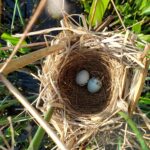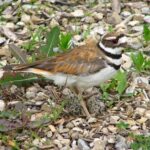By Casey Smith, Naturalist

While we still have some cold temperatures ahead of us, some birds are already thinking spring. Now is the time for owls in Ohio to find mates, and for birds that have migrated south to prepare for their return trip north. Before long we’ll hear the familiar songs of our resident bird friends.
Birds, and other animals, build nests in order to raise and protect their young. The variety in bird nests and eggs is incredible. From the utterly gigantic bald eagle nest to the miniscule hummingbird nest, each one is different in size, shape, and nest material. Eagle nests average 4-5 feet wide, 2-3 feet deep, and are made with large sticks lined with moss, grass, or sod. Hummingbirds use spider webs to bind together plant fibers and bits of leaves to create their golf ball sized nests. An eagle nest is considered a platform nest and a hummingbird builds a cup nest. There are also ground nests, cavity nests, burrows, and scrapes. For more information on nests, look for the bird nest poster, coming soon to a park kiosk near you.

Bird species can be identified by their eggs. The study of bird eggs is called Oology. While all bird eggs are roughly, well, egg-shaped, they vary in size and color. Ostrich eggs are 2,000 times larger than the smallest hummingbird egg, which is smaller than a blueberry. Egg colors serve many purposes. Studies have shown that blue eggs, like those of our springtime Robins, may protect the baby bird inside from UV rays. The eggs of cavity nesters, like owls or woodpeckers, tend to be white. If you’re a cavity nester, there’s no reason for your eggs to be further camouflaged. Many ground nesting birds produce speckled or streaked eggs that blend in well with their surroundings. Take the killdeer for instance. Their eggs are laid in gravel, and their babies look similar to the eggs. If a predator gets close to the highly camouflaged nest, a mother killdeer will pretend to be injured to lure it away. Because they nest on the ground, killdeer chicks hatch with a full coat of buffy down feathers and can walk out of the nest as soon as the feathers dry. They look like tiny walking cotton balls and are the cutest things you’ll ever see.
In North America, the Brown-headed Cowbird participates in Avian Brood Parasitism. This means that this bird lays its eggs in other birds’ nests. These parasitic birds need to neither incubate their eggs nor raise their young. Their eggs are speckled and are often laid in the nests of Eastern Phoebes, whose eggs are white. Other birds, like some duck species, will lay eggs in a communal nest and share parenting duties.
The shape, color, and size of eggs can tell us a lot about the birds they belong to. Adding oology to your list of hobbies is a great way to enhance your bird watching and identification skills. If you decide to learn more about bird eggs, please be respectful of the birds. Keep your distance to avoid stressing out the adult birds, and never handle wild bird eggs.






